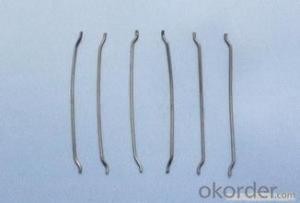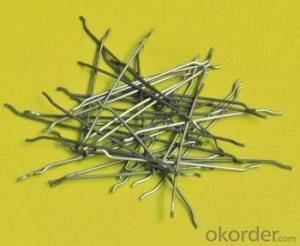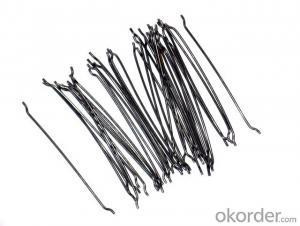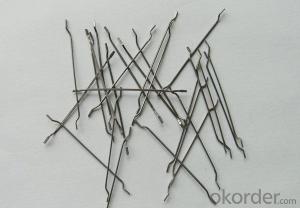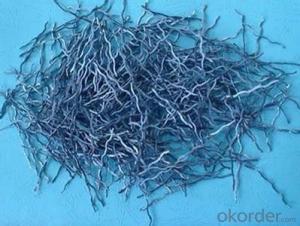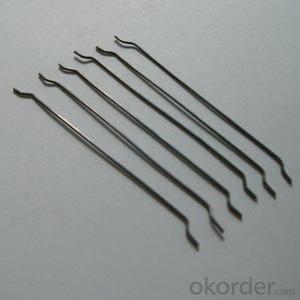Melt Extract Stainless Steel Fiber Loose from CNBM International
- Loading Port:
- Tianjin
- Payment Terms:
- TT OR LC
- Min Order Qty:
- 2000 kg
- Supply Capability:
- 30000 kg/month
OKorder Service Pledge
OKorder Financial Service
You Might Also Like
Quick Details
Place of Origin: Jiangsu, China (Mainland)
Model Number: HT-MC
Material: Color Steel
certificated: ISO 9001
Specifications
ISO 9001 certificated
2.70% for Europe, Middle Asia, America market
3.Have the most number of steel fiber machine in china
1. Material: low carbon steel wire or stainless steel
2.Diameter: 0.4mm-1.0mm
3.Length: meet your requirements
4.tensile strength >1000Mpa
6.Feature: excellent tensile,high tenacity,against cracking,impact and fatigue
7.Uses: highway road surface,tunnel,building,airport road surface and so on .
Straight Steel Fiber
1.ISO 9001 certificated
2.70% for Europe, Middle Asia, America market
3.Have the most number of steel fiber machine in china
Picture

Steel fiber
FAQ
certificated: ISO 9001
Technical advantages of Daye steel fiber:
A. Improve mechanical performance of concrete
B. Provide uniform distribution throughout concrete with excellent mixing
C. No balling or caking by adopt correct mixing method
D. Reduce concrete volume
E.Save construction time and cost
F.Reduce excavation volume
G.Available for jointless floor.
- Q: Can melt extract stainless steel fiber be used in pavement rehabilitation applications?
- Indeed, melt extract stainless steel fiber is applicable for pavement rehabilitation applications, as these fibers are meticulously crafted to enhance the efficacy and longevity of concrete and asphalt mixtures employed in such projects. The inclusion of stainless steel fibers augments the pavement's robustness and reinforcement, thereby bolstering its resistance against cracking, fatigue, and rutting. Moreover, they aid in managing the occurrence of shrinkage cracks while elevating the pavement's overall durability. Furthermore, the utilization of stainless steel fibers contributes to diminishing maintenance and repair expenses linked to pavement rehabilitation, rendering it a financially prudent solution for infrastructure undertakings.
- Q: Can melt extract stainless steel fiber be used in fiber-reinforced polymer (FRP) composites?
- Yes, melt extract stainless steel fiber can be used in fiber-reinforced polymer (FRP) composites. The addition of stainless steel fibers enhances the mechanical properties and durability of the composite material, making it suitable for various applications such as construction, automotive, and aerospace industries.
- Q: Can melt extract stainless steel fiber be used in architectural precast elements?
- Yes, melt extract stainless steel fiber can be used in architectural precast elements.
- Q: How does melt extract stainless steel fiber contribute to the ductility of concrete?
- There are several ways in which melt extract stainless steel fibers contribute to the ductility of concrete. Firstly, the addition of these fibers in small proportions enhances the overall flexural and tensile strength of the concrete, making it more ductile and capable of withstanding greater loads without cracking. Secondly, the unique properties of stainless steel, such as its high tensile strength and corrosion resistance, make it an ideal material for reinforcing concrete. When added as fibers, stainless steel provides additional reinforcement throughout the concrete, increasing its toughness and ductility. Moreover, the randomly dispersed stainless steel fibers act as micro-crack arresters, preventing cracks from propagating and improving the concrete's behavior after cracking. This means that even if cracks occur, they are less likely to spread and cause catastrophic failure. Additionally, the melt extract stainless steel fibers improve the bond between the concrete and the fibers themselves. This enhanced bond allows for more effective transfer of loads between the fibers and the surrounding concrete, further enhancing the material's ductility. In conclusion, melt extract stainless steel fibers contribute to the ductility of concrete by improving its flexural and tensile strength, enhancing crack resistance, and improving the bond between the fibers and the concrete. As a result, the concrete becomes more durable and resilient, capable of withstanding greater loads and deformation without failure.
- Q: Does melt extract stainless steel fiber improve the impact resistance of concrete pavement?
- Yes, melt extract stainless steel fiber can improve the impact resistance of concrete pavement. Stainless steel fibers are added to concrete mixtures to enhance the overall durability and performance of the pavement. These fibers act as reinforcement by dispersing throughout the concrete matrix, creating a 3-dimensional network that helps to distribute stress and absorb energy upon impact. The use of melt extract stainless steel fibers in concrete pavement can greatly enhance its impact resistance. These fibers have high tensile strength and excellent ductility, which allow them to absorb and dissipate energy more effectively when subjected to impact loads. As a result, concrete pavements reinforced with stainless steel fibers exhibit higher resistance to cracking, spalling, and other forms of damage caused by impact forces. Furthermore, melt extract stainless steel fibers can also improve the overall durability and longevity of the concrete pavement. They help to reduce the formation of shrinkage cracks, enhance the flexural strength, and increase the resistance to freeze-thaw cycles and chemical attacks. All these factors contribute to a more robust and long-lasting concrete pavement that can withstand heavy traffic loads and harsh environmental conditions. In conclusion, the addition of melt extract stainless steel fiber to concrete pavement can significantly improve its impact resistance. These fibers distribute stress and absorb energy upon impact, reducing the likelihood of cracking and damage. Moreover, they enhance the overall durability and longevity of the pavement, making it more resistant to various forms of deterioration.
- Q: Can melt extract stainless steel fiber be used in industrial chimney construction?
- Yes, melt extract stainless steel fiber can be used in industrial chimney construction. It is a durable and heat-resistant material that can withstand high temperatures and corrosive environments commonly found in chimneys. The use of stainless steel fiber helps to enhance the structural integrity and longevity of industrial chimneys, making it a suitable choice for construction.
- Q: Can melt extract stainless steel fiber be used in railway track construction?
- Yes, melt extract stainless steel fiber can be used in railway track construction.
- Q: Is melt extract stainless steel fiber compatible with different types of admixtures?
- Yes, melt extract stainless steel fiber is compatible with different types of admixtures. This type of fiber is commonly used in concrete to enhance its mechanical properties, such as tensile strength and durability. The addition of admixtures to concrete can further improve its performance by modifying certain properties, such as workability, setting time, and water-cement ratio. Melt extract stainless steel fibers are highly versatile and can be used in combination with various admixtures. For example, if a plasticizing admixture is added to improve workability, the stainless steel fibers can still be incorporated without any negative effects. Similarly, if a superplasticizer is used to increase the flowability of concrete, the stainless steel fibers can be included without compromising the effectiveness of the admixture. It is important to note that the compatibility of melt extract stainless steel fibers with admixtures can vary depending on the specific fibers and admixtures being used. Therefore, it is always recommended to consult the manufacturer's guidelines and conduct proper testing to ensure compatibility and achieve the desired concrete properties.
- Q: Can melt extract stainless steel fiber improve the resistance of concrete to fire?
- Yes, melt extract stainless steel fiber can improve the resistance of concrete to fire. Stainless steel fibers are known for their high melting point, corrosion resistance, and excellent heat conductivity, making them an ideal choice for enhancing the fire resistance of concrete. When added to concrete, these fibers create a three-dimensional reinforcement network that helps to prevent cracks and spalling during fire exposure. The stainless steel fibers also act as a heat sink, absorbing and dissipating heat more efficiently, which can significantly delay the temperature rise in the concrete, thus increasing its fire resistance. Additionally, the fibers enhance the overall strength and durability of the concrete, making it more resilient to fire and prolonging its structural integrity under high temperatures. Therefore, incorporating melt extract stainless steel fiber into concrete can indeed improve its resistance to fire.
- Q: What is the effect of melt extract stainless steel fiber on the durability of shotcrete?
- The use of melt extract stainless steel fiber in shotcrete can greatly enhance its durability. Shotcrete is a popular construction material that is typically sprayed onto surfaces, providing a strong and durable concrete layer. However, shotcrete can be prone to cracking and spalling over time, especially in harsh environmental conditions or under heavy loading. By incorporating melt extract stainless steel fiber into the shotcrete mix, the overall durability of the material is significantly improved. These fibers act as reinforcement, providing added strength and crack resistance to the shotcrete. The stainless steel fibers help to distribute stress and prevent the formation and propagation of cracks, thus enhancing the overall durability and lifespan of the shotcrete. The unique properties of melt extract stainless steel fibers make them ideal for shotcrete applications. They have high tensile strength, which allows them to effectively resist crack formation and propagation. Additionally, stainless steel fibers exhibit excellent corrosion resistance, even in aggressive environments, further enhancing the durability of the shotcrete. The addition of melt extract stainless steel fibers also improves the overall structural integrity of shotcrete. The fibers help to increase the flexural and shear strength of the material, making it more resistant to loading and impact forces. This enhanced structural integrity ensures that the shotcrete can withstand heavy loads, vibrations, and other external forces without significant damage or degradation. Overall, the incorporation of melt extract stainless steel fiber in shotcrete significantly improves its durability by enhancing crack resistance, corrosion resistance, and structural integrity. This results in a longer lifespan and reduced maintenance requirements for shotcrete structures, making it a highly beneficial addition to the construction industry.
Send your message to us
Melt Extract Stainless Steel Fiber Loose from CNBM International
- Loading Port:
- Tianjin
- Payment Terms:
- TT OR LC
- Min Order Qty:
- 2000 kg
- Supply Capability:
- 30000 kg/month
OKorder Service Pledge
OKorder Financial Service
Similar products
Hot products
Hot Searches
Related keywords

